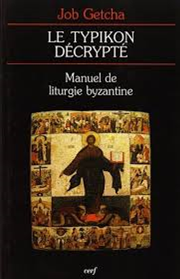Typikon

TYPIKON (GR "following the order"; "that of the prescribed form") literally means "ritual" and in the context of the Church refers to the pattern of rituals in conducting worship. The Orthodox Church has numerous books filled with readings, hymns, prayers and worship services. However, there is one book, titled the TYPIKON that prescribes what readings, hymns, prayers and worship services are to be combined and used on any particular day of any year. It is used in setting the order and hymns sung in each of the daily services of the Church, such as the Vespers, Orthros and Divine Liturgy, meaning what service is prescribed what hymns are sung and read that day, etc. The liturgical books presently used by the Orthodox Church have originated either in monasteries or have been greatly influenced by monastic practices. In monastic usage, the Typikon of the monastery includes both the rule of life of the community and the rule of prayer. The difficulty of using a monastic Typikon at the parish level came to a head by the beginning of the nineteenth century, and abbreviations and omissions of the services became widespread. Accordingly, the Ecumenical Patriarch authorized the revision of the Typikon for parish use. This revision became known as Ecclesiastical Typikon according to the Style of the Great Church of Christ (the Ecumenical Patriarchate of Constantinople), and was published in 1838. This revision was further revised by Protopsaltis George Violakes in the Typikon of the Great Church of Christ published in 1888 and commonly referred to as the Typikon of Violakis. The Church Typicon is a guidebook for training and schooling in prayer and the more it is adhered to the more benefit is derived from it.
Typikon
Le Typikon (ou Typicon) (GR « suivre l’ordre ») est un rituel contenant les instructions sur l’ordonnancement et les hymnes de l’office divin, sous forme d’un calendrier perpétuel, observées dans les Églises orthodoxes de rite byzantin. C’est donc le livre qui contient l’ensemble des règles permanentes à suivre pour la célébration des offices, selon les cycles journalier, hebdomadaire et annuel; il expose la structure, les prières, les hymnes et les textes, des Vêpres, des Matines, de la Divine Liturgie, des offices des fêtes, etc. Les livres liturgiques actuellement utilisés par l’Église orthodoxe trouvent leurs origines dans des monastères ou ont été grandement influencés par les pratiques monastiques. Dans l’usage monastique, le Typikon du monastère inclut à la fois la règle de vie de la communauté et la règle de prière. La difficulté d’utiliser un Typikon monastique au niveau des paroisses prend de l’ampleur au début du XIXe siècle, et les abréviations et les omissions des services se généralisent. En conséquence, le patriarche œcuménique autorise la révision du Typikon pour l’usage des paroisses. Cette révision, publiée en 1838, est connue sous le nom de Typikon ecclésiastique selon le rite de la Grande Église du Christ. En 1888, Georges Violakis — alors protopsalte (chantre) de la Grande Église (le patriarcat œcuménique de Constantinople) — en fait une autre révision et corrige les erreurs et les ambiguïtés. La version corrigée porte le nom de: Typicon de la Grande Église du Christ; elle est communément appelée le Typikon de Violakis et elle est encore en usage aujourd’hui dans la plupart des Églises orthodoxes. Le Typikon se veut un guide pour la formation et l’instruction dans la prière. Plus on y adhère, plus on en tire profit.